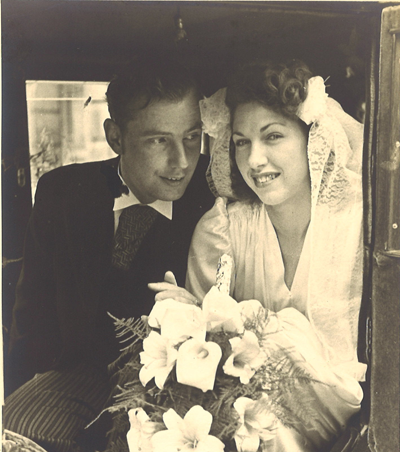

Recipes of a WWII Belgian War Bride

Born in Antwerp, Anny van Bommel was working in the USO Club in Brussels when she met Private John Garrison (although family lore holds that she was also a member of the Belgium Underground). Private Garrison had been drafted into the army during World War II and would serve two years and four months with the 35th Infantry, where he received two Purple Hearts. When his deployment ended, Garrison returned to Belgium and the couple, decked out in formal wear that harkened back to an earlier era, were married.
Anny joined the hundred thousand other women who married American G.I.s during World War II and emigrated to the United States under the War Brides Act enacted in December 1945. Although the U.S. government assisted war brides (the U.S. Army’s “Operation War Bride” reunited 70,000 wives with their spouses), Americans were not always welcoming to strangers (especially German and Asian wives) and American-born women complained that the influx of foreign women created a shortages of marriageable men. However, even when family and neighbors were accepting, life for women who married American soldiers was not always easy. Uprooted first by war and then separated from family by migration, these women were plunged into a rapidly changing America that, although prosperous, could not always match their romantic expectations of the “American Dream.”
Special Collection’s “Item of the Month,” a notebook prepared by Anny van Bommel before she left Belgium with her new husband, captures some of the conflicted feelings of a young war bride. The cookbook itself is in Flemish (Belgium Dutch) with recipes for favorite dishes that the young bride brought with her as a reminder of home.  The recipes are indexed, and the first section is given over to pastries, followed by soups, vegetables, beef, hors d’oeuvres, fish, wine and liquor, dessert, and some miscellaneous baked goods. There are recipes for mackerel, various cheeses, and dozens of desserts from apple turnovers to shortbread to Turkish delight. For Anny, these recipes must have evoked memories of her homeland. But the notebook also offers evidence of Anny’s dreams for life in America. Although a blue paper cover with the word “recepten” (recipes) neatly printed on the front transformed what may have been a school notebook into a cookbook, beneath the paper cover Anny etched a litany of American icons into the hardback cover. For Anny, music shaped her hopes for America. In black ink are testimonies to “jazztime,” “ragtime” and “swing.” She lists her favorite artists: Fats Waller, Lionel Hampton, The Mills Brothers, Ambrose (and his Orchestra), Louis Armstrong, Cab Calloway, and Benny Goodman. And she records the names of beloved songs: Glenn Miller’s “In the Mood,” Benny Goodman’s “Bugle Call Rag,” The Dixieland Jazz Band’s “Tiger Rag,” Tommy Dorsey’s “Indian Summer,” Cole Porter’s “Begin the Beguine,” Freddy Martin’s “Scatter-brain,” and Duke Ellington’s “Caravan.”
The recipes are indexed, and the first section is given over to pastries, followed by soups, vegetables, beef, hors d’oeuvres, fish, wine and liquor, dessert, and some miscellaneous baked goods. There are recipes for mackerel, various cheeses, and dozens of desserts from apple turnovers to shortbread to Turkish delight. For Anny, these recipes must have evoked memories of her homeland. But the notebook also offers evidence of Anny’s dreams for life in America. Although a blue paper cover with the word “recepten” (recipes) neatly printed on the front transformed what may have been a school notebook into a cookbook, beneath the paper cover Anny etched a litany of American icons into the hardback cover. For Anny, music shaped her hopes for America. In black ink are testimonies to “jazztime,” “ragtime” and “swing.” She lists her favorite artists: Fats Waller, Lionel Hampton, The Mills Brothers, Ambrose (and his Orchestra), Louis Armstrong, Cab Calloway, and Benny Goodman. And she records the names of beloved songs: Glenn Miller’s “In the Mood,” Benny Goodman’s “Bugle Call Rag,” The Dixieland Jazz Band’s “Tiger Rag,” Tommy Dorsey’s “Indian Summer,” Cole Porter’s “Begin the Beguine,” Freddy Martin’s “Scatter-brain,” and Duke Ellington’s “Caravan.”
By the 1960s, John and Anny were well established. John, who had been born in Washington, D.C., but went to live with relatives in Columbus, Mississippi, when he was thirteen, had risen through the ranks at Hederson’s Brothers, the printing concern owned by the publishers of The Clarion-Ledger. Anny owned Ann’s Dress and Fabric in Raymond, Ms. The couple had a daughter and attended the Raymond Presbyterian Church. John belonged to the Lions Club, the V. F. W. and the American Legion, and Anny made annual trips to Belgium to visit her family. John and Anny’s daughter, Candice Tuell, who joined her mother on those trips to Belgium, donated her mother’s cookbook to Southern Miss’ Special Collections in December 2018.
To learn more about this item or the collections, contact Jennifer Brannock at Jennifer.Brannock@usm.edu or 601.266.4347.
Text by Dr. Andrew P. Haley, Associate Professor of History, University of Southern Mississippi
1 Lucy Greenbaum, “In Marriage It’s a Man’s Market,” New York Times Magazine, June 17, 1945, 14.
2 Gertrude Samuels, “Forty Thousand GI Brides Appraise Us,” New York Times, December 1, 1946, 200.
3 “In Foxholes of Europe, Garrison Dreamed of a Job” Clarion-Ledger Monday, December 3, 1962 pg 35